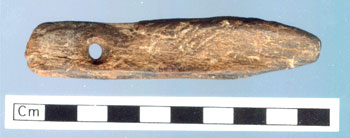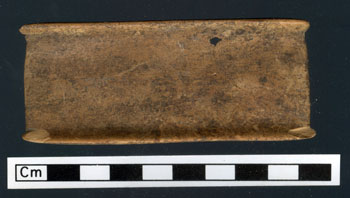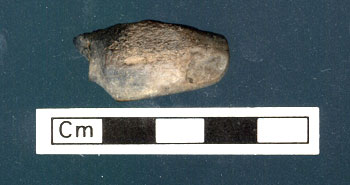ÇATALHÖYÜK 2005 ARCHIVE REPORT
| |
CULTURAL AND ENVIRONMENTAL MATERIALS REPORTS
Worked Bone
Stanford University
Abstract
During the 2005 season 210 worked bone items were recorded, both from backlog and from current excavation. This brings the total of recorded worked bone items to 1451. The worked bone items were mainly of types found in previous seasons, but one new type, a flat plaque or palette, was found as well as a few distinctive but unidentifiable pieces. Points continued to be the dominant type, accounting for 100 (or 48%) of the total worked bone items, followed in importance by beads at 28 (or 13%), and needles and preforms at 11 (or 5%) each. All types found at Çatalhöyük are listed in Table 1. Of those, only seven will be discussed below, as they provided new information. These are: Points, Burnishers, Miscellaneous Perforated Tools, Pallettes, Beads, Preform/Waste, and Unidentified. The other tool types found were very similar in detail to the same types as discussed earlier.
Özet
2005 sezonunda, hem geçen senelerden kalan, hem de yeni sezonda ortaya çıkarılan 210 adet işlenmiş kemik kaydedildi. Bu sayı, şimdiye kadar kaydedilmiş olan işlenmiş kemik sayısını 1451’e ulaştırdı. Işlenmiş kemik eserler, geçmiş senelerde bulunan örneklere benzemekle beraber, düz şekilli palete benzeyen ve tanımlanamayan bir kaç belirgin parça göze çarptı. Sivri uçlu aletler, işlenmiş kemik buluntuların % 48’ini oluştururken (100), boncuklar %13 (28) , iğneler ile performlar ise %5’ini (11) kapsamaktadır. Çatalhöyük’de bulunan tüm örnekler Tablo 1’de listelenmiştir. Yeni bilgi sunmaları açısından bu örneklerin yalnızca 7 adeti bu raporda tartışılacaktır. Bu örnekler: Sivri uçlular, cila aletleri, delikli aletler, paletler, boncuklar, artıklar ve betimlenemeyenler. Bulunan diğer örnekler, daha önce tartışılan örneklere benzemektedirler.
Introduction
During the 2005 season I recorded 210 worked bone items, both from backlog and from current excavation. This brings the total of recorded worked bone items to 1451: these are broken down by type for both the current season and overall in Table 1. The worked bone found up to 1999 is discussed in the excavation volumes (Russell, in press), so I will not go into great detail about each type of item here, instead concentrating on new information. The usual faunal information was recorded for each of the tools (although modification often makes identification difficult by removing diagnostic characters). In addition to noting morphological data, the tools were examined for microwear under a binocular light microscope at magnifications 25-150X.
Tool types
The worked bone items were mainly of types found in previous seasons, but one new type, a flat plaque or palette was found, as well as a few distinctive but unidentifiable pieces. Points continued to be the dominant type, accounting for 100 (or 48%) of the total worked bone items, followed in importance by beads at 28 (or 13%), and needles and performs at 11 (or 5%) each. All types found at Çatalhöyük are listed in Table 1. Of those, only seven will be discussed below, as they provided new information. These are: Points, Burnishers, Miscellaneous Perforated Tools, Pallettes, Beads, Preform/Waste, and Unidentified. The other tool types found were very similar in detail to the same types as discussed earlier.
Point
Points accounted for just under half (48%) of the assemblage analyzed this year, continuing the trend from previous years. Points made with heavily abraded distal metapodials continued to appear all over the site, again indicating that they are indeed appearing before the Chalcolithic period, as Russell speculated in the archive report for 2003. The most interesting point tools are the antler pieces - there are 7 antler points (10384.X2, 11588.X3, 11905.X4, 11924.X4, 11965.X6, 10396.F2, 11862.F124), two of which are listed as points, four of which are rounded points, and one of which is a blunted point. These antler points are very similar in appearance to the pieces described last year as pressure flakers: however, they were not found in similar contexts (in several locations across the site), or with closely associated obsidian, and nor did they show distinctive enough wear to be clearly identified as pressure flakers based on that alone. 11924.X4 and 11965.X6 were found near the cattle rib burnishers discussed below, and those with 11965.X6 especially may have represented a bone toolkit.
Burnisher
Six burnishers, most likely for use with pottery, were found this year. Five of these (11923.X1, 11923.X6, 11923.F1, 11923.F2, 11923.F3) were definitely made from cattle ribs and were found in the same context in Building 52, and the sixth (11892.F1, found in the South) was made from a large mammal rib that is most likely cattle. The five cattle rib burnishers that were found in the same context were in close association, and had been burned in situ, along with antler points that might have been pressure flakers, a sizeable quantity of oil rich seeds, and several unmodified metapodials that could have been stored as raw material for point manufacture.
Miscellaneous Perforated Tools
Figure 71. An Antler bullroarer 11910.X1. |
There were three miscellaneous perforated tools analyzed this year. One, 11910.X1, is an antler bullroarer. The bullroarer shows significant polish and wear inside the perforation, on the edges near the perforation, and on one side, indicating that it might have been worn when not in use as a bullroarer. The bullroarer was found in a bin in Building 52, which also housed the burned rib burnishers, the unmodified metapodials, and the possible pressure flakers.
The other two miscellaneous perforated objects were 11812.X37 and 11802.X15. They come from related contexts, arbitrary levels containing eroded and slumped deposits that have no clear plan. They are extremely similar to each other, but not to anything else found thus far. Each piece is around three centimeters long, and has three perforations running along the long axis. In both case, the perforations do not appear to have been made at the same time, as they were not made using the same techniques: some are unidirectionally perforated and others bidirectionally, and they use different types of drill. Both are highly polished in all sides but show little sign of wear within the perforation. It is tempting to suggest that they might be gaming pieces of some sort, but no evidence exists to suggest that this is the case.
Figure 72. Miscellaneous perforated objects 11812.X37 and 11802.X15. |
Pallettes
Figure 73. Palette 12238.X1. |
A single palette, item 12238.X1, was found this year in TP near a cluster of human and animal bones, unit 12240. It is a flat plaque or plate made from a split large aurochs rib. The rib was flattened, smoothed and polished on both sides. Edges were formed on the two long sides by retaining the sides of the rib, creating small lips. The short sides are not contained, but do have a small rounded protrusion at each corner. On microscopic examination,
small traces of an orange/red pigment were found in pores on the original inner rib surface. This piece is strikingly similar to items Mellaart described as wrist guards for archery, but the presence of pigment and the lack of any means of attachment indicate that it was most likely not used as such.
Beads
Twenty-seven of the 28 beads came from a single child’s burial, on two strands of anklet. They were all perforated mustelid teeth, and were present on the anklets interspersed with turquoise and carnelian beads. While the teeth all came form the same kind of animal, they probably did not come from the same animal. They had also not been on the same suspension system from the start of their lives as beads. Some of the beads had perforations that were nearly worn through (11657.F1, 11657.F15, 11657.F23, 11657.F25), and had obviously been in use for a long period of time, much longer than the child buried with them had been alive. However, other beads had very new perforations and did not appear to have been worn much, if at all (11657.F2, 11657.F4, 11657.F8, 11657.F9, 11657.F21, 11657.F22, 11657.F27), while still others had low to moderate wear (11657.F3, 11657.F5, 11657.F6, 11657.F, 11657.F10, 11657.F11, 11657.F13, 11657.F14, 11657.F19, 11657.F20, 11657.F24, 11657.F26), and so could have been used by the child throughout its life, or have been in use prior to its birth. The single bead not from this burial was an extremely long tubular bead made from the shaft of a large bird long bone, and was not excavated this year.
Preform/Waste
There are quite a few different preforms, but the only really notable ones are the three large chunks of antler, 11907.X4, 11907.X3, and 11874.X3. The first two are from the context partly covering (11923), which contained the rib burnishers, the possible pressure flakers, and the unworked curated metapodials, while the third is from the South shelter. 11907.X3 and 11907.X4 are very large chunks of antler (11907.X3 at just over 31cm and 11907.X4 at nearly 41cm long as preserved) that were in the process of becoming smaller tools when they, along with the rest of house 52, burned heavily. They preserve many of the traces of early work, but had clearly not been significantly modified other than general shaping.
Unidentified
Figure 74. Flattened and shaped piece of scapular blade 5381.F2. |
The unidentified bones included one late period (Roman or Byzantine) gaming piece, four severely broken antler tools, at least one of which might have been a point and one of which might have been a spatula, a sheep metapodial and sheep/goat metacarpal and tibia that were worn on the remaining, handle area, but broken in such as way as to completely remove and distinctive traces of their working ends, an oddly flattened and shaped piece of scapular blade, and 11357.X1 and 5381.F2, from an earlier excavation season. Both of the latter two are shaped from large mammal long bones. 5381 is a spoon-like shape, while 11357.X1 is more interesting, with a rounded point at one end and a spatula-like blade at the other. One side if flattened while the other retains the natural roundness of the outer surface of the long bone.
Discussion
While many of the tools found during the 2005 season are types previously recorded, more types continue to appear. These new types tended to come from unusual contexts, such as the burned Building 52, or from slightly problematic near surface/near intrusive later burial deposits. The removal of Building 51 should allow access to whatever remains of Building 52, which should help to clarify the context of these finds.
|
2005 |
Total |
Point |
100 48% |
697 48% |
Rounded point |
7 3% |
17 1% |
Blunted point |
3 1% |
4 0.03% |
Needle |
11 5% |
106 7% |
Harpoon |
0 |
1 0.01% |
Pick |
0 |
2 0.1% |
Hammer |
0 |
2 0.1% |
Pounder |
0 |
1 0.01% |
Chisel/gouge |
7 3% |
24 2% |
Chopper |
0 |
1 0.01% |
Scraper |
0 |
8 0.6% |
Punch |
0 |
1 0.01% |
Pressure flaker |
0 |
4 0.3% |
Soft hammer |
0 |
6 0.4% |
Pottery polisher |
0 |
17 1% |
Burnisher |
6 3% |
13 0.9% |
Plaster tool |
0 |
12 0.8% |
Haft/handle |
0 |
8 0.6% |
Fishhook |
2 1% |
11 0.8% |
Weight |
0 |
1 0.01% |
Spoon |
1 0.1% |
4 0.3% |
Spatula |
10 5% |
15 1% |
Bowl/cup |
0 |
2 0.1% |
Knucklebone |
3 1% |
18 1% |
Ornament |
0 |
15 1% |
Pendant |
1 0.1% |
25 2% |
Bead |
28 13% |
99 7% |
Ring |
5 2% |
106 7% |
Belt hook/eye |
0 |
5 0.3% |
Collar |
0 |
6 0.4% |
Preform/Waste |
11 5% |
102 7% |
Miscellaneous perforated tools |
3 1% |
3 0.2% |
Flute |
0 |
1 0.01% |
Palette |
1 0.1% |
1 0.01% |
Indeterminate |
11 6% |
116 8% |
Total |
210 |
1451 |
Table 1. Type representation for both 2005 items and all items



